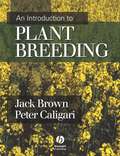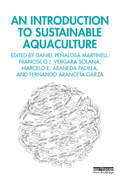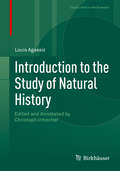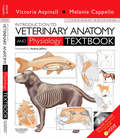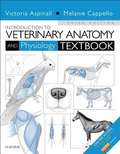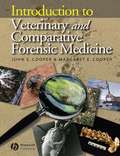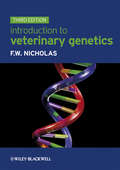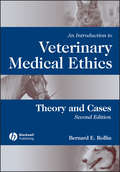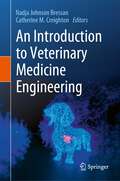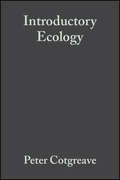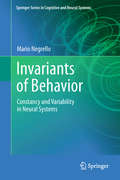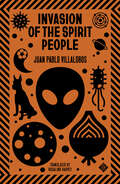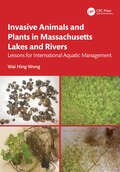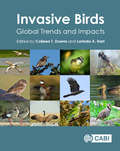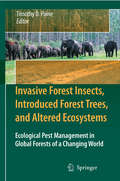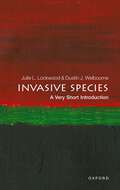- Table View
- List View
An Introduction to Plant Breeding
by Jack Brown Peter CaligariPlants have been successfully selectively bred for thousands of years, culminating in incredible yields, quality, resistance and so on that we see in our modern day crops and ornamental plants. In recent years the techniques used have been rapidly advanced and refined to include molecular, cell and genetic techniques. An Introduction to Plant Breeding provides comprehensive coverage of the whole area of plant breeding. Covering modes of reproduction in plants, breeding objectives and schemes, genetics, predictions, selection, alternative techniques and practical considerations. Each chapter is carefully laid out in a student friendly way and includes questions for the reader. The book is essential reading for all those studying, teaching and researching plant breeding.
An Introduction to Plant Breeding
by Jack Brown Peter CaligariPlants have been successfully selectively bred for thousands of years, culminating in incredible yields, quality, resistance and so on that we see in our modern day crops and ornamental plants. In recent years the techniques used have been rapidly advanced and refined to include molecular, cell and genetic techniques. An Introduction to Plant Breeding provides comprehensive coverage of the whole area of plant breeding. Covering modes of reproduction in plants, breeding objectives and schemes, genetics, predictions, selection, alternative techniques and practical considerations. Each chapter is carefully laid out in a student friendly way and includes questions for the reader. The book is essential reading for all those studying, teaching and researching plant breeding.
An Introduction to Sustainable Aquaculture
by Daniel Peñalosa Martinell Vergara-Solana, Francisco J Araneda Padilla, Marcelo E Fernando Aranceta GarzaThis new textbook provides an accessible introduction to sustainable aquaculture through its relationship with three key pillars: the environment, the economy, and society.As the demand for seafood keeps increasing, aquaculture is considered one of the most promising and sustainable ways to satisfy this demand with nutritious and high-quality food. It is important to understand, therefore, the wider role and impact aquaculture has on the environment, the economy, and society. The book begins by providing a foundational introduction to aquaculture and sustainability, discussing the complex and interdependent relationship that exists between the two. The core text of the book is divided into four parts which focus on the environment, economics, social impacts, and governance and technologies. Chapters examine key issues surrounding climate change, food security, new technologies, bioeconomics and risk analysis, international cooperation, employment, and animal welfare, with the book concluding with a chapter examining the future directions and challenges for the aquaculture industry. The book draws on global case studies and each chapter is accompanied by recommended reading and chapter review questions to support student learning.This book will serve as an essential guide for students of aquaculture, fisheries management, and sustainable food, as well as practitioners and policymakers engaged in sustainable fishery development.
An Introduction to Sustainable Aquaculture
by Daniel Peñalosa Martinell Francisco J. Vergara-Solana Marcelo E. Araneda Padilla Fernando Aranceta GarzaThis new textbook provides an accessible introduction to sustainable aquaculture through its relationship with three key pillars: the environment, the economy, and society.As the demand for seafood keeps increasing, aquaculture is considered one of the most promising and sustainable ways to satisfy this demand with nutritious and high-quality food. It is important to understand, therefore, the wider role and impact aquaculture has on the environment, the economy, and society. The book begins by providing a foundational introduction to aquaculture and sustainability, discussing the complex and interdependent relationship that exists between the two. The core text of the book is divided into four parts which focus on the environment, economics, social impacts, and governance and technologies. Chapters examine key issues surrounding climate change, food security, new technologies, bioeconomics and risk analysis, international cooperation, employment, and animal welfare, with the book concluding with a chapter examining the future directions and challenges for the aquaculture industry. The book draws on global case studies and each chapter is accompanied by recommended reading and chapter review questions to support student learning.This book will serve as an essential guide for students of aquaculture, fisheries management, and sustainable food, as well as practitioners and policymakers engaged in sustainable fishery development.
Introduction to the Study of Natural History: Edited and Annotated by Christoph Irmscher (Classic Texts in the Sciences)
by Louis Agassiz Christoph IrmscherThis book features Louis Agassiz’s seminal lecture course in which the Swiss-American scientist, a self-styled “American Humboldt,” summarized the state of zoological knowledge in his time. Though Darwin’s theory of evolution would soon dismantle his idealist science, Agassiz’s lectures are nonetheless modern in their insistence on the social and cultural importance of the scientific enterprise.An extensive, well-illustrated introduction by Agassiz’s biographer, Christoph Irmscher, situates Agassiz’s lectures in the context of his life and nineteenth-century science, while also confronting the deeply problematic aspects of his legacy. Profusely annotated, this edition offers fascinating insights into the history of science and appeals to anyone with an interest in zoology and natural history. “Christoph Irmscher provides a scholarly and insightful analysis of the intentions and beliefs of Louis Agassiz, a larger-than-life scientist of the mid-19th century and fierce opponent of Charles Darwin. One of the foremost naturalists of his time, Agassiz’s encyclopedic knowledge and brash confidence sustained bold and often controversial theories, which contributed to extreme intellectual ferment at the dawn of contemporary evolutionary biology.” James Hanken, Alexander Agassiz Professor of Zoology, Harvard University, USA
Introduction to Veterinary Anatomy and Physiology E-Book
by Victoria Aspinall Melanie CappelloA sound knowledge of anatomy and physiology is an essential basis for the effective clinical treatment of companion animals. The new Introduction to Veterinary Anatomy and Physiology Textbook builds on the success of the first edition in its thorough coverage of the common companion animal species. Updated throughout, the new edition features online learning resources, providing students with the opportunity to test their knowledge with questions and visual exercises, while instructors can download questions, figures and exercises to use as teaching aids.An essential first purchase for all those embarking upon a veterinary careerNow with on-line resources including self-assessment tools and teaching aidsComprehensive coverage of all major companion animal speciesNew equine chapter'Applied Anatomy' tips relate theory to clinical practice, showing the relationship between anatomy and physiology and the disease process
Introduction to Veterinary Anatomy and Physiology Textbook
by Victoria Aspinall Melanie CappelloA sound knowledge of anatomy and physiology is an essential basis for the effective clinical treatment of companion animals. The new third edition Introduction to Veterinary Anatomy and Physiology Textbook offers clear and comprehensive of the common companion animal species.Updated throughout with a new section added on large companion animals, the new edition features augmented online learning resources with new questions and quizzes. Students can test their knowledge with multi-choice questions, drag and drop exercises and an image bank, while instructors can download questions, figures and exercises to use as teaching aids. - An essential first purchase for all those embarking upon a veterinary career - Includes augmented on-line resources with self-assessment tools and teaching aids - Comprehensive coverage of all major companion animal species - New large animal section added covering the cow, sheep and pig - 'Applied Anatomy' tips relate theory to clinical practice, showing the relationship between anatomy and physiology and the disease process
Introduction To Veterinary Anatomy And Physiology Textbook (PDF)
by Victoria Aspinall Melanie CappelloA sound knowledge of anatomy and physiology is an essential basis for the effective clinical treatment of companion animals. The new third edition Introduction to Veterinary Anatomy and Physiology Textbook offers clear and comprehensive of the common companion animal species. Updated throughout with a new section added on large animals, the new edition features augmented online learning resources with new questions and quizzes. Students can test their knowledge with multi-choice questions, drag and drop exercises and an image bank, while instructors can download questions, figures and exercises to use as teaching aids. An essential first purchase for all those embarking upon a veterinary career Includes augmented on-line resources with self-assessment tools and teaching aids Comprehensive coverage of all major companion animal species New large animal section added covering the cow, sheep and pig 'Applied Anatomy' tips relate theory to clinical practice, showing the relationship between anatomy and physiology and the disease process
Introduction to Veterinary and Comparative Forensic Medicine
by John E. Cooper Margaret E. CooperIntroduction to Veterinary and Comparative Forensic Medicine is a ground-breaking book in an emerging new speciality. It reflects the increasing demand for expert opinion by veterinarians and others in courts of law and elsewhere on such matters as: · wildlife conservation, · welfare of, and alleged cruelty to, animals, · insurance, certification and malpractice · the identification of live and dead species or their derivatives. It also discusses and analyses current concern over possible links between domestic violence and abuse of animals. Throughout the book the emphasis is on the need for a systematic and thorough approach to forensic work. A particular feature is practical advice, with protocols on dealing with common problems, together with case studies, various appendices and an extensive bibliography. A vital reference for members of the veterinary profession, lawyers, enforcement bodies and welfare and conservation organisations. The comparative aspects provide an important source of information for those working in human forensic medicine and the biological sciences.
Introduction to Veterinary Genetics
by Frank W. NicholasThe concepts of veterinary genetics are crucial to understanding and controlling many diseases and disorders in animals. They are also crucial to enhancing animal production. Accessible and clearly presented, Introduction to Veterinary Genetics provides a succinct introduction to the aspects of genetics relevant to animal diseases and production. Now in its third edition, this is the only introductory level textbook on genetics that has been written specifically for veterinary and animal science students. Coverage includes: basic genetics, molecular biology, genomics, cytogenetics, immunogenetics, population genetics, quantitative genetics, biotechnology, and the use of molecular tools in the control of inherited disorders. This book describes in detail how genetics is being applied to artificial selection in animal production. It also covers the conservation of genetic diversity in both domesticated and wild animals. New for the Third Edition: End-of-chapter summaries provide quick recaps. Covers new topics: epigenetics, genomics and bioinformatics. Thoroughly revised according to recent advances in genetics. Introduction to Veterinary Genetics is still the only introductory genetics textbook for students of veterinary and animal science and will continue to be an indispensable reference tool for veterinary students and practitioners alike.
Introduction to Veterinary Genetics
by Frank W. NicholasThe concepts of veterinary genetics are crucial to understanding and controlling many diseases and disorders in animals. They are also crucial to enhancing animal production. Accessible and clearly presented, Introduction to Veterinary Genetics provides a succinct introduction to the aspects of genetics relevant to animal diseases and production. Now in its third edition, this is the only introductory level textbook on genetics that has been written specifically for veterinary and animal science students. Coverage includes: basic genetics, molecular biology, genomics, cytogenetics, immunogenetics, population genetics, quantitative genetics, biotechnology, and the use of molecular tools in the control of inherited disorders. This book describes in detail how genetics is being applied to artificial selection in animal production. It also covers the conservation of genetic diversity in both domesticated and wild animals. New for the Third Edition: End-of-chapter summaries provide quick recaps. Covers new topics: epigenetics, genomics and bioinformatics. Thoroughly revised according to recent advances in genetics. Introduction to Veterinary Genetics is still the only introductory genetics textbook for students of veterinary and animal science and will continue to be an indispensable reference tool for veterinary students and practitioners alike.
An Introduction to Veterinary Medical Ethics: Theory and Cases
by Bernard E. RollinOne of the most difficult issues that confronts veterinarians and staff today concerns the profession’s obligation to the animal and the sometimes conflicting demands from clients, peers and society. The veterinarian’s role has become more complex with new ethical challenges posed by issues such as growing public awareness regarding animal welfare, increasing economic value of companion animals, growth of veterinary specialization, experimentation with alternative and complementary medicine, and concern for pain management and mental well-being of animals. Written by an acknowledged pioneer in veterinary ethics, An Introduction to Veterinary Medical Ethics addresses the ethical challenges that veterinarians face daily as they seek to balance obligations to animal, client, peers, society and self. The book offers a highly readable and approachable introduction to the nature of ethical theory, reasoning and decision-making, and its practical application to veterinary medicine. Now with over 100 real-life veterinary case histories and analysis, this edition also includes new discussions of animal pain, distress and happiness, ethics of critical care, alternative medicine, legal status and value of animals, and Aesculapian authority. An Introduction to Veterinary Medical Ethics: Theory and Cases, Second Edition is recommended as essential reading for all veterinary students and practitioners, as well as those interested in general animal welfare. New edition from an acknowledged pioneer in veterinary ethics Addresses ethical challenges that veterinary medicine, with over 100 real-life cases Includes new discussion of legal status and value of animals, alternative medicine, Aesculapian authority, ethics and critical care, and animal pain, distress and happiness Ideal for veterinary students and practitioners
An Introduction to Veterinary Medical Ethics: Theory and Cases
by Bernard E. RollinOne of the most difficult issues that confronts veterinarians and staff today concerns the profession’s obligation to the animal and the sometimes conflicting demands from clients, peers and society. The veterinarian’s role has become more complex with new ethical challenges posed by issues such as growing public awareness regarding animal welfare, increasing economic value of companion animals, growth of veterinary specialization, experimentation with alternative and complementary medicine, and concern for pain management and mental well-being of animals. Written by an acknowledged pioneer in veterinary ethics, An Introduction to Veterinary Medical Ethics addresses the ethical challenges that veterinarians face daily as they seek to balance obligations to animal, client, peers, society and self. The book offers a highly readable and approachable introduction to the nature of ethical theory, reasoning and decision-making, and its practical application to veterinary medicine. Now with over 100 real-life veterinary case histories and analysis, this edition also includes new discussions of animal pain, distress and happiness, ethics of critical care, alternative medicine, legal status and value of animals, and Aesculapian authority. An Introduction to Veterinary Medical Ethics: Theory and Cases, Second Edition is recommended as essential reading for all veterinary students and practitioners, as well as those interested in general animal welfare. New edition from an acknowledged pioneer in veterinary ethics Addresses ethical challenges that veterinary medicine, with over 100 real-life cases Includes new discussion of legal status and value of animals, alternative medicine, Aesculapian authority, ethics and critical care, and animal pain, distress and happiness Ideal for veterinary students and practitioners
An Introduction to Veterinary Medicine Engineering
by Nadja Johnson Bressan Catherine M. CreightonDo cephalopods change color when under distress? Is the reptilian heart analogous to a diaphragm positive displacement pump? Are digital twins the answer for animal experimentation? This book explores the new field of veterinary engineering science and discusses how to better measure vital signs in exotic and companion animals. A vast opportunity exists for developing novel technologies that target reductions to the number of invasive procedures patients are subjected to. We examine improvements to animal care and enhancement of animal welfare while creating a more sustainable veterinary healthcare ecosystem. The authors address the challenges engineers face in designing healthcare equipment for animals and how the field of veterinary engineering contributes to traditional veterinary medicine. This book brings a novel field of engineering to train future veterinarians and engineers on design and application of technology to veterinary medicine.Serves as a learning resource for the training and education of veterinary students, veterinarians and engineersDemonstrates through experiments and case studies the merging point between engineering and veterinary medicineDiscusses concepts and issues associated with engineering and veterinary medicineIllustrates veterinary challenges using an engineering-design approachProvides examples of veterinary applications with successful outcomes, incorporating step-by-step directions for engineers
Introductory Ecology
by Peter Cotgreave Irwin ForsethIn this age of increasing human domination of the Earth's biological and physical resources, a basic understanding of ecology is more important than ever. Students need a textbook that introduces them to the basic principles of ecological science, one that is relevant to today's world, and one that does not overwhelm them with detail and jargon. Peter Cotgreave and Irwin Forseth have designed this book to meet the needs of these students, by providing a basic synthesis of how individual organisms interact with their physical environment, and with each other, to generate the complex ecosystems we see around us. The unifying theme of the book is biodiversity-its patterns, causes, and the growing worldwide threats to it. Basic ecological principles are illustrated using clearly described examples from the current ecological literature. This approach makes the book valuable to all students studying ecology. Examples have been chosen carefully to represent as wide a range of ecosystems (terrestrial and aquatic, northern and southern hemisphere) and life forms (animal, plant and microbe) as possible. Particular attention is paid to consequences of global change on organisms, populations, ecological communities and ecosystems. The end result is a text that presents a readable and persuasive picture of how the Earth's natural systems function, and how that functioning may change over the coming century. Features include: · strong coverage of applied and evolutionary ecology · applications of ecology to the real world · a question-orientated approach · the only comprehensive treatment of ecology written for the introductory student · an emphasis on definitions of key words and phrases · an integration of experimental, observational and theoretical material · examples drawn from all over the world and a wide variety of organisms · a logical structure, building from the response of individual organisms to physical factors, through population growth and population interactions, to community structure and ecosystem function · suggested further reading lists for each chapter · boxes to explain key concepts in more depth · dedicated textsite featuring additional information and teaching aids www.blackwellpublishing.com/cotgreave Peter Cotgreave is an animal ecologist who has worked for the University of Oxford and the Zoological Society of London. His research interests centre on abundance and rarity within animal communities. Irwin Forseth is a plant physiological ecologist who has taught introductory ecology and plant ecology at the University of Maryland since 1982. His research focuses on plant responses to the environment. The authors have studied organisms as diverse as green plants, insects and mammals in habitats from deserts to tropical rainforests. They have worked in ecological research and education in Africa, Asia, North and South America, Europe and the Caribbean.
Invaluable Invertebrates and Species with Spines: Inquiry-Based Science Lessons for Advanced and Gifted Students in Grades 2-3
by Jason S. McIntoshRecipient of the 2022 NAGC Curriculum AwardInspire the next generation of zoologists with this 30-lesson interdisciplinary science unit geared toward second and third grade high-ability students.Using problem-based learning scenarios, this book helps students develop the vocabulary, skills, and practices of zoologists as they conduct research and solve real world problems. Students will gain an in-depth understanding of how the animal kingdom is structured, create an innovative zoo exhibit containing an entire ecosystem for a vertebrate animal of their choosing, design invertebrate animal trading cards, and much, much more. Featuring detailed teacher instructions and reproducible handouts, this unit makes it easy for teachers to adjust the rigor of learning tasks based on students’ interests and needs.Aligned with Common Core State Standards for English Language Arts and Mathematics plus the Next Generation Science Standards, gifted and non-gifted teachers alike will find this expedition into the animal kingdom engaging, effective, and highly adaptable.
Invaluable Invertebrates and Species with Spines: Inquiry-Based Science Lessons for Advanced and Gifted Students in Grades 2-3
by Jason S. McIntoshRecipient of the 2022 NAGC Curriculum AwardInspire the next generation of zoologists with this 30-lesson interdisciplinary science unit geared toward second and third grade high-ability students.Using problem-based learning scenarios, this book helps students develop the vocabulary, skills, and practices of zoologists as they conduct research and solve real world problems. Students will gain an in-depth understanding of how the animal kingdom is structured, create an innovative zoo exhibit containing an entire ecosystem for a vertebrate animal of their choosing, design invertebrate animal trading cards, and much, much more. Featuring detailed teacher instructions and reproducible handouts, this unit makes it easy for teachers to adjust the rigor of learning tasks based on students’ interests and needs.Aligned with Common Core State Standards for English Language Arts and Mathematics plus the Next Generation Science Standards, gifted and non-gifted teachers alike will find this expedition into the animal kingdom engaging, effective, and highly adaptable.
Invariants of Behavior: Constancy and Variability in Neural Systems (Springer Series in Cognitive and Neural Systems)
by Mario NegrelloThe study of the brain and behavior is illuminated with the discovery of invariances. Experimental brain research uncovers constancies amidst variation, with respect to interventions and transformations prescribed by experimental paradigms. Place cells, mirror neurons, event related potentials and areas differentially active in fMRI, all illustrate the pervasive role of invariances in neural systems in relation to their function.
Invasion of the Spirit People
by Juan Pablo VillalobosJuan Pablo Villalobos’s fifth novel adopts a gentle, fable-like tone, approaching the problem of racism from the perspective that any position as idiotic as xenophobia can only be fought with sheer absurdity.In an unnamed city, colonised by an unnamed world power, an immigrant named Gastón makes his living selling exotic vegetables to eateries around the city. He has a dog called Kitten, who’s been diagnosed with terminal cancer, and a good friend called Max, who’s in a deep depression after being forced to close his restaurant. Meanwhile, Max’s son, Pol, a scientist away on a scientific expedition into the Arctic, can offer little support.Faced with these dispiriting problems, Gastón begins a quest, or rather three: he must search for someone to put his dog to sleep humanely; he must find a space in which to open a new restaurant with Max; and he must look into the truth behind the news being sent back by Pol: that human life may be the by-product of an ancient alien attempt at colonisation . . . and those aliens might intend to make a return visit.
Invasive Animals and Plants in Massachusetts Lakes and Rivers: Lessons for International Aquatic Management
by Wai Hing WongThere is a growing demand for appropriate management of aquatic invasive species in lakes and rivers worldwide. This book covers biology, invasion ecology, sightings, and control techniques of 4 invasive animals and 15 invasive plants in Massachusetts lakes and rivers. It provides valuable information on their biological characteristics and potential expansion pathways, as well as monitoring and management, including alternative management tools using updated biological, chemical, and mechanical methods. The book also includes the regulation of invasive species management to allow resource managers, biologists, practitioners, volunteers, and students a better understanding of compliance and enforcement with environmental law. An example of successful management is highlighted for each invasive species. Invasive Animals and Plants in Massachusetts Lakes and Rivers is the first book to provide comprehensive and systematic coverage and illustrations for both freshwater invasive animals and plants. Although focussing on Massachusetts, it will provide readers with the bigger picture on multiple invasive species, from prevention, early detection, control, ecological restoration, to public education. Natural resource managers in Massachusetts and surrounding states will glean the detailed and valuable information they need to learn and use to prevent and manage freshwater invasive species in the field.
Invasive Animals and Plants in Massachusetts Lakes and Rivers: Lessons for International Aquatic Management
by Wai Hing WongThere is a growing demand for appropriate management of aquatic invasive species in lakes and rivers worldwide. This book covers biology, invasion ecology, sightings, and control techniques of 4 invasive animals and 15 invasive plants in Massachusetts lakes and rivers. It provides valuable information on their biological characteristics and potential expansion pathways, as well as monitoring and management, including alternative management tools using updated biological, chemical, and mechanical methods. The book also includes the regulation of invasive species management to allow resource managers, biologists, practitioners, volunteers, and students a better understanding of compliance and enforcement with environmental law. An example of successful management is highlighted for each invasive species. Invasive Animals and Plants in Massachusetts Lakes and Rivers is the first book to provide comprehensive and systematic coverage and illustrations for both freshwater invasive animals and plants. Although focussing on Massachusetts, it will provide readers with the bigger picture on multiple invasive species, from prevention, early detection, control, ecological restoration, to public education. Natural resource managers in Massachusetts and surrounding states will glean the detailed and valuable information they need to learn and use to prevent and manage freshwater invasive species in the field.
Invasive Birds: Global Trends and Impacts
by Alexander Cruz Tim Adriaens Craig R Allen Michael L Avery Alexander V Badyaev Fabrice M Brescia Sarah E Britton Daniel M Brooks Jessica L. Burnett Matthew Burnett Corey T Callaghan César Capinha Jen Cele Jameson F Chace Jocelyn Champagnon Alice Cibois Andrew Close Alyssa R Conn Richard T Corlett Adrian J Craig Amy E Dunham James A Eaton David A Smith Yvette C Smith Mike W Eichholz Johan Elmberg Cyril Eraud Chris L Feare Jason M Gleditsch Guillaume G Gayet Matthieu Guillemain Carlos Gutiérrez-Expósito Haley E Hanson Iain Henderson Frank Huysentruyt John G Innes Salit Kark Michael R Leven Ricardo J Lopes Jean-Francois Maillard Ndivhuwo Maligana Chloe I Marcheli Lynn B Martin Blake A Mathys Erik Matthysen Myriam E Mermoz Jean-Yves Meyer Dai K Morgan Katherine G Ohman Claire Pernollet Murray A Potter Bill Pranty Juan Carlos Reboreda Eileen C Rees Luís Reino Joana Ribeiro Peter A Robertson Andrew M Rogers Philip D Round Joana Santana Cavin T Shivambu Neftalí Sillero Preshnee Singh Pär Söderquist Karina L Speziale Diederik Strubbe Martin J Sullivan Jean-Claude Thibault Martin Thibault Berndt J van Rensburg Eric Vidal Joseph R Waas Amy-Leigh Wilson Katherine Winston Kevin A Wood Pierre Yésou Ding Li Yong Jaime E ZolikExamining globally invasive alien birds, the first part of this book provides an account of 32 global avian invasive species (as listed by the Invasive Species Specialist Group, ISSG). It acts as a one stop reference volume; it assesses current invasive status for each bird species, including details of physical description, diet, introduction and invasion pathways, breeding behaviour, natural habitat. It also looks at the environmental impact of each species, as well as current and future control methods. Full colour photographs assist with species identification and global distribution maps give a visual representation of the current known distributions of these species. The second part of the book discusses the biogeographical aspects of avian invasions, highlighting current and emerging invasive species across different regions of the world. The third section considers the impact of invasive species on native communities, problems associated with invasive bird management and the use of citizen science in the study of invasive birds.
Invasive Forest Insects, Introduced Forest Trees, and Altered Ecosystems: Ecological Pest Management in Global Forests of a Changing World
by Timothy D. PaineDemand for timber and fibre continues to grow and is being met by increased reliance on plantation forestry. Many of the plantations that are being grown around the globe are non-native species that have characteristics of rapid growth and good commercial qualities. In some cases, the high rates of production are a result of the absence of native herbivore and diseases. This limited pest status is threatened as pest species move around the globe. At the same time there is concern about threats of these non-native plantation species on native communities and the impact of changing climates on forest productivity. This volume explores many of these issues for the first time.
Invasive Species: A Very Short Introduction (Very Short Introductions)
by Julie Lockwood Dustin J. WelbourneToday there is no place on Earth that does not harbour invasive exotic species. Invasive plants and animals can be found on every continent, including Antarctica, and within all waterbodies, including all oceans. In our increasingly connected world, with speedy commercial and recreational travel and the global movement of biological matter for food, invasive species are showing up at such a fast rate that there is no way to accurately count how many currently exist or how many are likely to emerge in the coming decades. Monitoring these species and controlling their spread is essential, as we increasingly understand the negative impacts they pose: their threat to our health; the toll they take on our commercial production; and the threat they pose to native ecosystems. This Very Short Introduction provides a clear definition of an invasive species, and considers the myriad ways they are moved around the globe, and the ecological, social, and economic impacts they often impose. Exploring the way Earth's biodiversity is being affected by global change, Julie Lockwood also discusses policy and management approaches to combating the ill-effects of invasive species, and how invasive species fit within the broader context of environmental change. ABOUT THE SERIES: The Very Short Introductions series from Oxford University Press contains hundreds of titles in almost every subject area. These pocket-sized books are the perfect way to get ahead in a new subject quickly. Our expert authors combine facts, analysis, perspective, new ideas, and enthusiasm to make interesting and challenging topics highly readable.
Invasive Species: A Very Short Introduction (Very Short Introductions)
by Julie Lockwood Dustin J. WelbourneToday there is no place on Earth that does not harbour invasive exotic species. Invasive plants and animals can be found on every continent, including Antarctica, and within all waterbodies, including all oceans. In our increasingly connected world, with speedy commercial and recreational travel and the global movement of biological matter for food, invasive species are showing up at such a fast rate that there is no way to accurately count how many currently exist or how many are likely to emerge in the coming decades. Monitoring these species and controlling their spread is essential, as we increasingly understand the negative impacts they pose: their threat to our health; the toll they take on our commercial production; and the threat they pose to native ecosystems. This Very Short Introduction provides a clear definition of an invasive species, and considers the myriad ways they are moved around the globe, and the ecological, social, and economic impacts they often impose. Exploring the way Earth's biodiversity is being affected by global change, Julie Lockwood also discusses policy and management approaches to combating the ill-effects of invasive species, and how invasive species fit within the broader context of environmental change. ABOUT THE SERIES: The Very Short Introductions series from Oxford University Press contains hundreds of titles in almost every subject area. These pocket-sized books are the perfect way to get ahead in a new subject quickly. Our expert authors combine facts, analysis, perspective, new ideas, and enthusiasm to make interesting and challenging topics highly readable.
